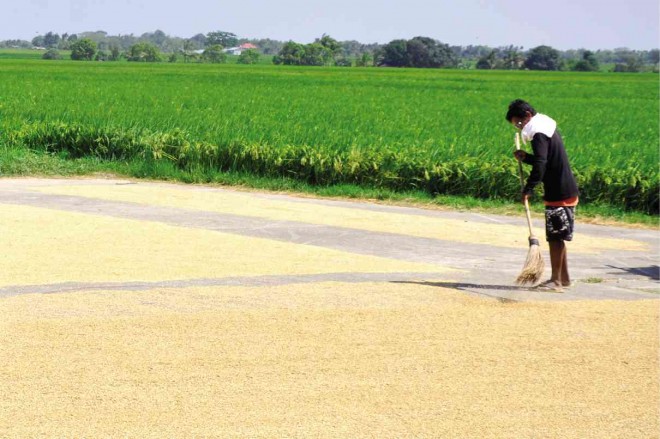El Niño: 140,000 ha of rice farms in CL to get less water

IN THIS photo taken in March, a farmer in the Science City of Muñoz in Nueva Ecija province takes advantage of good weather to dry his palay harvest. The Department of Agriculture has warned farmers of a low water supply for the dry cropping season this year due to the prolonged drought brought about by the El Niño weather phenomenon. WILLIE LOMIBAO/Inquirer Northern Luzon
CITY OF SAN FERNANDO—Almost 140,000 hectares of rice lands in three Central Luzon provinces may suffer low water supply in this year’s dry season cropping in October due to prolonged drought brought about by the El Niño weather phenomenon, an agriculture official said.
Andrew Villacorta, Central Luzon regional director of the Department of Agriculture (DA), gave this outlook based on the forecast of the Philippine Atmospheric, Geophysical and Astronomical Services Administration (Pagasa) that rainfall volume, starting October, would be reduced by 50 to 60 percent.
“The wet season cropping is delayed by two to four weeks in Amris areas (Angat-Maasim River Irrigation System, spanning 30,000 ha). [However], if Angat Dam can recover by August and Upriis (Upper Pampanga River Integrated Irrigation System) is fed by Pantabangan Dam, then the rice lands can survive,” Villacorta told the Inquirer on Monday.
He said the lack of water during the dry season cropping would make it difficult for rice growers to store water for irrigation until March, he said, citing latest information by the National Irrigation Administration for Amris and Upriis.
The so-called weak El Niño in 2014 lowered the water level in Pantabangan Dam to 204 meters above sea level (masl), which is 4 meters below its ideal level.
In Angat Dam, the water level was recorded at 170 masl as of 8 a.m. on Monday, 10 m below its critical level.
This year’s El Niño is of the same scale as the 1997 and 1998 events when storms and floods were more severe, Pagasa said.
Villacorta said the lack of irrigation in the region may cut down the target output of 3.8 million metric tons (MT) of rice harvest by 75,000 MT.
Rice is grown in 430,000 ha during the wet season and 330,000 ha during the dry season. At least 20 percent of the national rice production comes from Central Luzon.
In March, 2.208 million MT of rice were harvested in 346,344 ha of rice lands in Central Luzon. Local governments in the region reported that rice had been planted in 28,687 ha of irrigated lands and 29,559 ha of rain-fed lands.
To help farmers cope with the drought, Villacorta said the DA had set aside P220 million for the purchase of pumps and the construction of diversion dams and small water impounding systems.
As rice growers brace for the rainy months, however, the price of palay (unhusked rice) has gone down from P24 a kilogram during the last season to P17 to P19 a kg this month, information gathered from farmers in the region showed. Tonette Orejas, Inquirer Central Luzon














